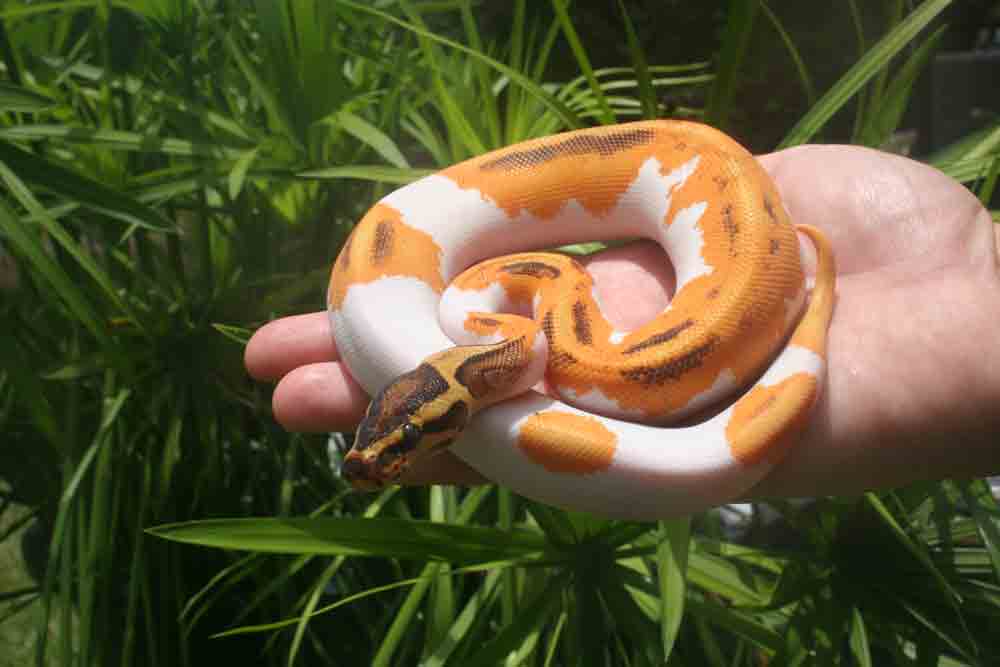The ball python (Python regius) goes by many names, but perhaps the most accurate of all is “favorite.”
The ball python (Python regius) goes by many names, but perhaps the most accurate of all is “favorite.” Ball pythons continue to be one of the most popular reptiles as they are constantly being kept, discussed, and diversified. Their popularity exploded around the 1990s, but their history goes back much further. They are a very common reptile kept throughout the world, but their traits are unique and specialized. Although ball pythons are often described as a great “beginner species,” they can be far more complex than generally thought. This is important to consider when keeping them in captivity. Their species-specific history, establishment and diversity are just a few of the reasons that make ball pythons so loved and favored by many reptile keepers.
Ball Python Description and Wild Habitat
Ball pythons are a mostly terrestrial, non-venomous species of constrictor native to Western and Central Africa. Ball pythons are commonly kept as pets due to their manageable sizes, temperaments, availability, and color morph variety. They are the smallest python in their genus, but not the smallest python that exists. Although smaller, ball pythons are thickly built for their Sub-Saharan habitat where they live as mostly nocturnal, ground dwellers. They are adapted to the tropical and subtropical grasslands, savannas, and shrublands which are semi-humid and semi-arid. These terrestrial habitats are dominated by grasses, shrubs, and trees in their natural ranges. They frequently use logs, burrows, and other natural structures to hide, lay their eggs, and aestivate in the wild. These are important factors to consider for their captive conditions, which will be discussed further in this article.
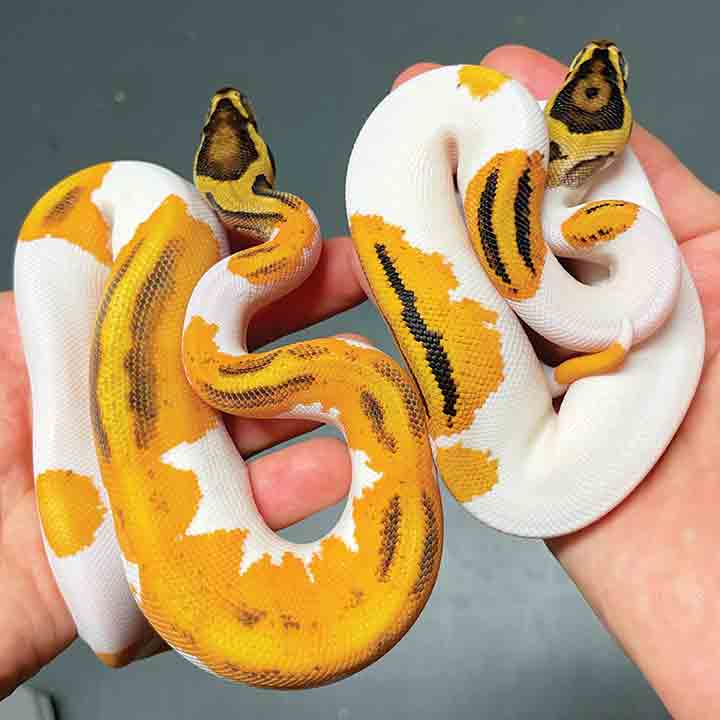
Yellow Belly Enchi Pied. Photo by Rebekah Pettit.
Sexual dimorphism exists in the species as adults only, and females are both heavier and longer than males on average. Adult females have been documented up to 6ft in the largest specimens, but average between 4.5 to 5 feet. Adult males are typically between 2.5-3.5 feet. It is important to remember that each animal is individual and size depends on a variety of captive or wild factors. Ball pythons can range in weight as adults, but females are always heavier due to the dimorphism of the species. Like all snakes, Ball pythons are carnivorous and hunt a variety of prey species in the wild.
Ball Python Taxonomic History
Ball python classification has changed over time, and Python regius is the accepted scientific name of today. Python regius translates to ‘Royal Python,’ which is their most popular common name besides ‘ball python.’ Different ideas surround the origins of these common names, from their behavior of curling in a tight ball to the ophiolatry (snake worship) in some African cultures.
There are multiple levels within taxonomy which break down the classification of a species. These levels are called taxons, which include orders, families, subfamilies, suborders, superfamilies and so on. The scientific name is the most specific description of an organism, consisting of the genus and species levels only. These names and groups are often discussed in Herpetology and can change with time, technology, and new research.
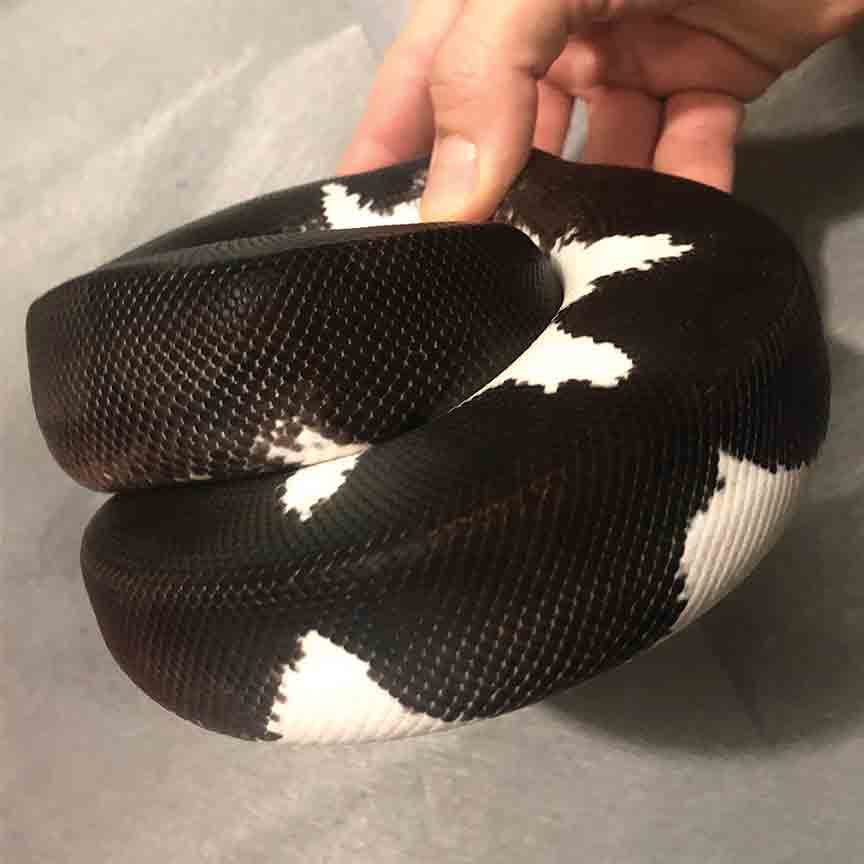
Ball pythons come in a wide variety of morphs. Photo by Rebekah Pettit
All snakes, including ball pythons, are classified under the suborder Serpentes. There are more than 20 snake families within the Serpentes suborder which are frequently being discussed and revised. These include the Boidae, Colubridae, and Pythonidae families which are commonly called boas, colubrids, and pythons. Ball pythons are described within the Pythonidae family, with Python as the genus and regius as the species. Therefore, their scientific name is Python regius. There are more than 40 species of pythons in the Pythonidae family which are found throughout Africa, Asia and Australia. Since none are found in the Americas, pythons are considered to be old world snakes. These include a vast variety of species like the green tree python (Morelia viridis), rock python (Python sebae), Burmese python (Python bivittatus), reticulated python (Malayopython reticulatus), olive python (Liasis olivaceus), and black-head python (Aspidites melanocephalus) to mention few.
All pythons were once classified with the boas, and the debate between the two groups is ongoing. This has contributed to the common and scientific description of ball pythons, which goes back hundreds of years! Although there are similarities between the constricting boas and pythons, their differences ultimately separated them, like their reproductive strategies. Ball pythons are strictly oviparous, or egg laying, whereas Boas give live birth, called viviparous. Current evidence suggests that boas and pythons evolved much earlier than other snake families and they may have a common ancestor, which is why they share characteristics.
The first proposed scientific name for ball pythons was Boa regius, described by Zoologist George Shaw in 1802. This was not the first study on ball pythons though, as Shaw used illustrations from another scientist, Albertus Seba, who conducted the first official study on the species in the mid-1700s. His research was mainly illustrations and brief descriptions. Shaw used the illustrations of the boldly patterned, African snake species to give it its first scientific name, Boa regius. He used the common name “Royal boa” at this time, as he was from London.
In 1803, Zoologist Francois Daudin proposed the name python for the group of “nonvenomous flecked constrictors.” In the 1820s, all pythons were categorized in the superfamily Pythonoidea, and by the 1840s the ball python’s scientific name was changed to Python bellii. These snakes continued to be discussed taxonomically and were placed in the subfamily Boidae in the 1890s. Close to 100 years later, ball pythons were finally placed in the Pythonidae family where they remain today. Before, during, and even now, ball pythons have been discussed using a variety of synonyms such as Hortuglia regia, Pythoninae, Cenchris regia, and Shireenhoserus regia. The historical fascination of this species is perhaps part of the reason they eventually rose to be one of the most popular snakes ever.
Ball Pythons in Captivity
The history of ball pythons in captivity has changed just as much as their classification. Captive bred reptiles are always preferred to wild counterparts, though genetic integrity may be questioned in some conservation contexts. The history of ball pythons in herpetoculture has not been clearly documented, but they eventually became one of the most popular reptiles kept today. They have manageable temperaments, sizes, and eventually proved to be easily bred.
In the past, ball python availability was scarce and captive breeders nonexistent. During this time, they were often (legally) imported from Africa for a few private collections and zoos. These were often farmed or collected from the wild to meet export quotas. One book, published in 1987 called “Living Snakes of the World in Color,” described ball pythons as rare and challenging to adapt to captivity. Care information was limited just as their supply was in the USA and other countries. Today, ball pythons can be easily found for legal purchase at pet stores, reptile shows, online stores, and captive breeders. Captive breeding has helped alleviate the pressures of wild collection for ball pythons and ultimately eliminated any illegal trade of the species. This has also helped reduce the challenges associated with wild caught animals, which include stress, parasites, viral and bacterial infections and more.
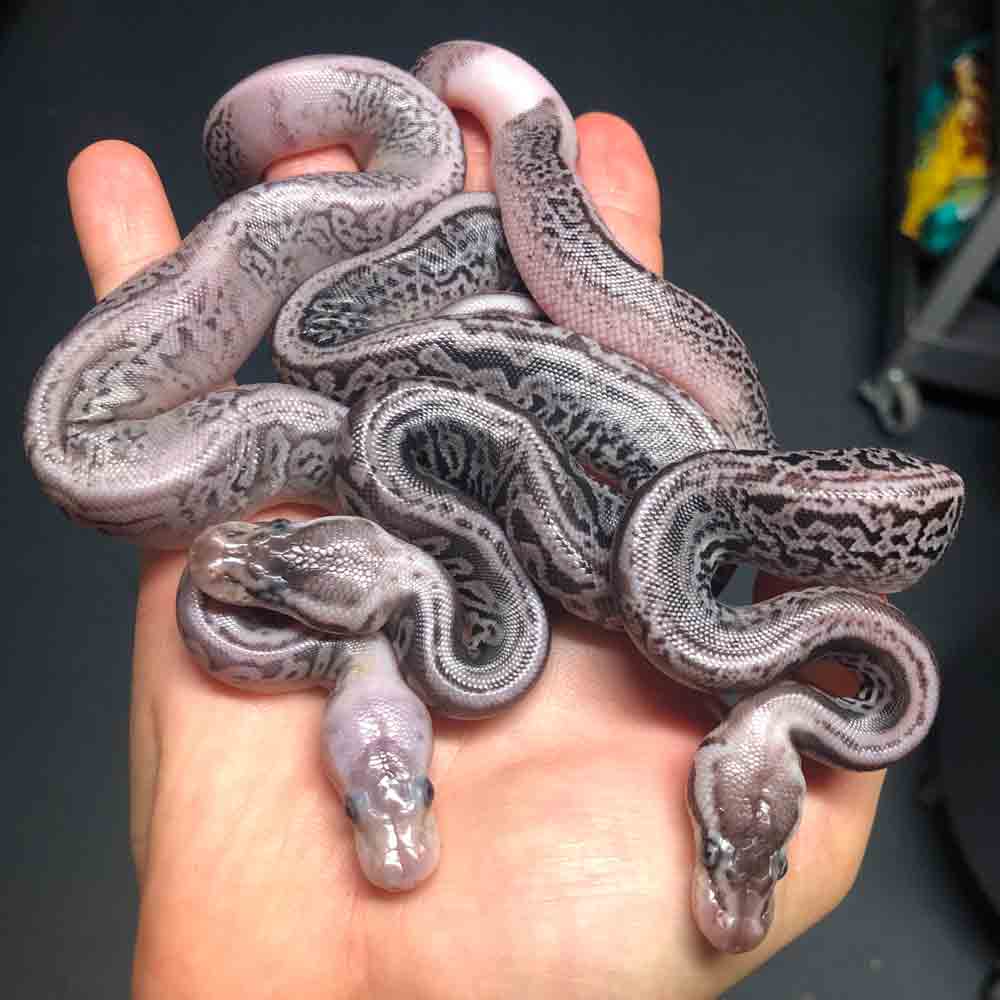
Ball python colorations are seemingly endless. Photo by Rebekah Pettit
Although ball pythons are listed as “least concern” by the International Union for Conservation of Nature (IUCN), their population status is unknown and they are still collected for food and other products in their wild ranges. Between 1997 – 2018, 3.5 million ball pythons have been exported as “ranched specimens” from Ghana, Togo, and Benin. While it is still possible to import/export them from the wild, this requires complicated permits and is usually unnecessary. Like most animals, permits are required for the trade and commerce of ball pythons, dead or alive. By the 1990s, the demand for ball pythons required hobbyists and commercial breeders to rapidly expand the industry. This popularity made it possible to better understand the unique traits and care requirements of ball pythons, while also establishing a professional industry of the species.
Ball Python Morphs
When George Shaw studied ball pythons in 1802, he described them as a “white boa, with a longitudinally striped neck, and body variegated either with brown and grey, or orange and rose-colour.” It seems that color and pattern was always a noticeable trait in the species, even when referencing normals! Perhaps this was a foreshadowing of the future fixation on the diversity of ball pythons genetic expression. Normal ball pythons are perfect as is, but exploring the variable color wheel became exciting for so many.
When these snakes were historically imported from the wild, there would be some specimens that looked different from the rest. These variabilities in pattern and color were wild type mutations that would be later described as “morphs.” These occurrences are rare in nature, but can be expressed through the species’ genetic variability. There are over 50 wild morphs documented that range in colors, patterns, and even texture. Genetic diversity is a crucial trait to the survival of species in the wild, and ball pythons have remarkable color possibilities naturally. This characteristic was isolated by selective breeding to create a variety of man made genetic mutations.
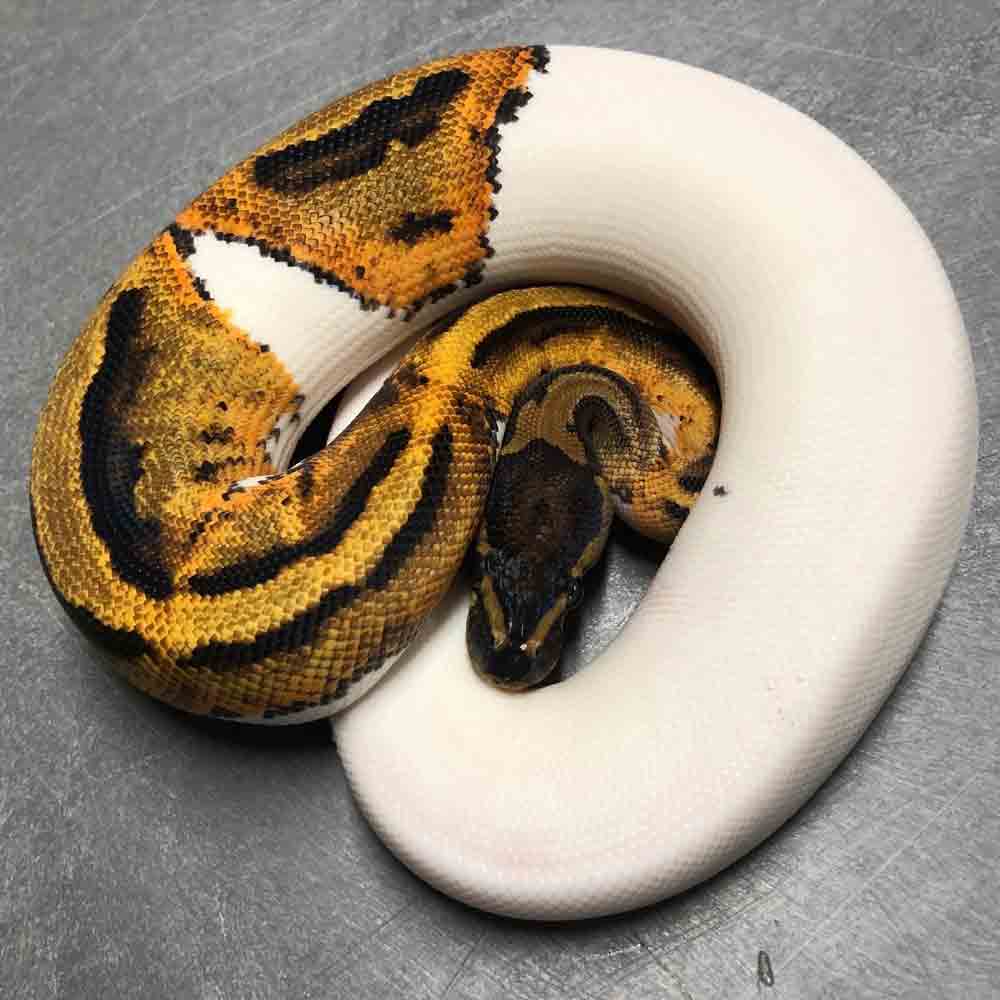
Ball pythons are ideal snakes for intermediate reptile keepers. Photo by Rebekah Pettit.
Genetic mutations are an abnormal sequence change in the building blocks of DNA. These involve chromosomes, alleles, and loci genes that can be expressed visually or non-visually. Ball pythons have many genetic combinations which result in a variety of patterns and color expressions. These genetic combinations are extremely detailed and variable depending on the specific pairings. This roulette style color palette in ball pythons fascinated the world and elevated them to be one of the most popular snakes ever kept in the reptile industry.
From the 1990s to the present, ball pythons have been successfully captive bred to showcase their docile temperaments and variable genetic expressions. Breeding the species has since expanded and there are now thousands of hobbyist and commercial breeders around the world. It is important to find a reputable breeder since there are now many who vary in quality. The ball python has a broad genetic color spectrum which has allowed breeders to specialize and focus on certain genes. Here at Trademark Exotics, piebaldism is the main focus of current ball python breeding projects.
A Crash Course In Ball Python/Reptile Genetics
There are many morph combinations which are mostly for superficial and cosmetic beauty. Some of the first morphs ever isolated for designer breeding include albinos and pastels. Morphs have ranged greatly in value and price over time and new mutations are still being discovered. Morph pricing is variable and is based on supply and demand which can range from below $100 to more than $10,000 for an individual animal. Ball python popularity is becoming even more established within many groups including small and commercial businesses, hobbyists, and pet owners. Ball pythons have also interested scientific research teams who are using these groups of animals for various academic studies. Along with their general popularity, ball pythons have a significant economic value being a multi-million dollar industry as a whole. Ball pythons will most likely continue to grow in popularity and be further explored, especially genetically.
Ball Python Husbandry
Ball pythons can easily live more than 30 years with the proper husbandry. Information regarding their captive care has expanded greatly in the last few decades and practices differ between pet owners, breeders, and large scale hobbyists. Snake husbandry is still understudied, but ball python care has progressed with popularity and the variety of information databases. These have included forums, books, reptile shows and Herpetological societies, but these should not ever be substituted for professional veterinary advice. Ball pythons can be successfully kept in captivity under the species specific requirements which are similar in hatchling and adult animals. Improper captive care can compromise the immune system of reptiles, resulting in a variety of illnesses. Proper husbandry involves replicating their wild conditions for the most naturalistic experience possible.
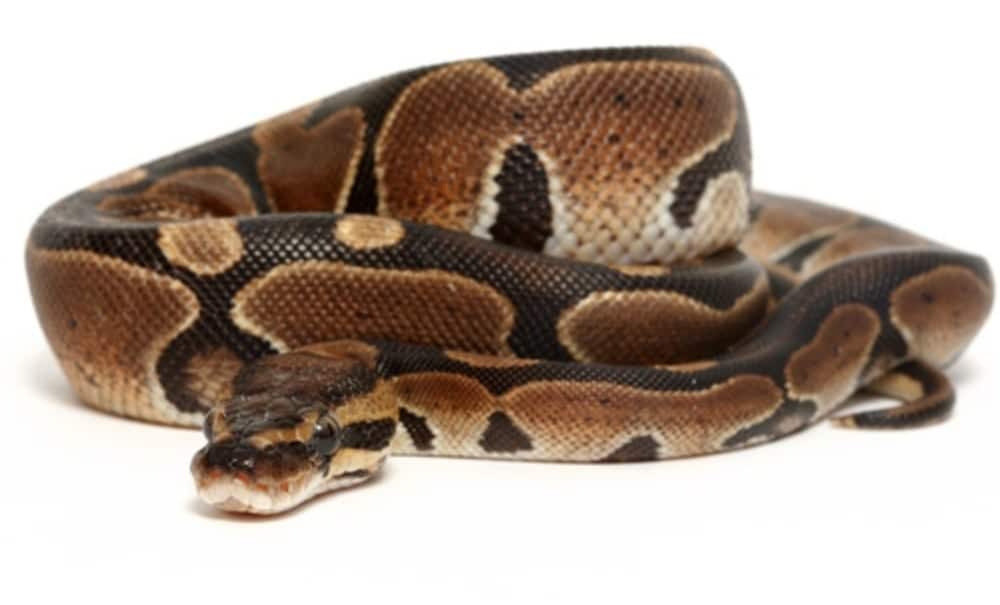
A normal ball python sells for about $65. Photo by Gina Cioli.
Ball pythons can be kept in a variety of captive habitats. Large enclosures with plenty of space for burrowing climbing and hiding are ideal. Since they are native to a subtropical/tropical climate with wet and dry seasons, humidity and temperature are extremely important factors for ball python health. Humidity and temperature should be monitored with proper tools like thermostats, thermometers, and hygrometers. Attainable captive conditions can vary depending on the climate of the captive location.
Ideal Ball Python Humidity
Humidity is a natural requirement of ball pythons. This assists in the shedding process and overall health of the species. Humidity can be attained with high quality room humidifiers and tweaking a variety of factors like air movement, ventilation, and substrate variety. Hygrometers should be used to document and monitor humidity levels. Dry periods should also be provided to avoid saturation and replicate the arid/dry seasons they experience in the wild. This helps prevent mildew, fungus, and bacteria from growing in the captive setting, but levels should not go below 55% relative humidity. At Trademark Exotics, this dry period is provided a few days per month.
Best Ball Python Substrate
There are many substrate varieties that are used by keepers including coco husk, aspen bedding, and blank newsprint paper as some of the most popular options. Substrates should be able to hold humidity well but not create overly wet conditions. This will be specific for each keeper and their location. For a more humid snake room, blank packing paper or aspen bedding are suitable substrate options.
For a drier room, cypress mulch and large chunk coco husk substrates help provide humid conditions in captivity. Some keepers combine and mix substrates of these options. Fine substrates like powdery coco blocks should be avoided, as they can clog the heat pits, mouth, and cloacal vents of ball pythons, which is very bad for them!
Temperature, Light and Heat for Ball Pythons
Animals should be housed individually unless breeding and the habitat should have a temperature gradient for thermoregulation. This is achieved by providing a hot and cool side of the habitat, which allows the snakes to regulate their body temperatures naturally. Ball pythons typically do not require overhead UVB lighting, but it does not harm them when properly provided. Ball pythons absorb heat best from underneath, so heat pads or heat tape can be used to provide a hot spot. Overhead heat bulbs or ceramic heat emitters can be used to perfect ambient temperatures.
Thermostats are absolutely required to safely provide proper light and heat in captivity. Without these tools, snakes can be burned or killed by overheating. Temperatures between 77-85 degrees Fahrenheit (25 to 29.4 degrees Celsius) all year are suitable and some keepers are very specific with monitoring temperatures between the night and day. As a general rule, temperatures should not go below 77 degrees Fahrenheit (25 degrees Celsius) at night. Improper and inconsistent humidity, lighting, heat, and temperature can result in various health issues. Perfect captive husbandry is highly debated among ball python keepers and each scenario will always be individual.
Ball Python Hides
A variety of hides should be provided in captivity to replicate the wild structures ball pythons utilize. These can include branches, shrubs, hide boxes, or other custom structures. These hides are used for thermoregulation, security, and dormancy during the day. They can also provide enrichment, which is important for all captive animals.
Ball Python Diet
Ball pythons are carnivorous constrictors and feed almost exclusively on feeder rodents in captivity. Feeding schedules depend on the keeper and are debated among them. Preference differs between individual animals in regards to live and frozen/thawed rodents, which are both suitable options. Ball pythons constrict and consume prey items whole, and most keepers feed their ball pythons once a week. Hatchlings should be fed once a week and adults can eat less, but larger meals. Hatchlings are almost always started on live, and after a handful of meals, they are more apt to accept frozen/thawed rodents if offered properly. Hatchlings will usually eat their first meal after they shed for the first time, between one and two weeks after hatching, but assisted feeding may be necessary in some individuals. Feeding schedules and appropriate sized rodents are debated among keepers. In the wild, ball pythons will ambush a variety of prey species opportunistically.
Ball Python Breeding
Ball pythons are now easily bred in captivity and hatchlings are almost always available for legal purchase. Breeding ball pythons has to do with many factors including size, age, and experience of the keeper and animal(s). Each animal is individual and must be carefully observed and monitored for success. Steady consistency is required for healthy animals and clutches should not be catalyzed by overfeeding for accelerated growth. Overfeeding is unnatural which can cause obesity and other health issues. It is possible for ball pythons to be sexually mature and not produce viable clutches for many years. Like most reptiles, ball python reproduction is sexual and fertilization is internal.
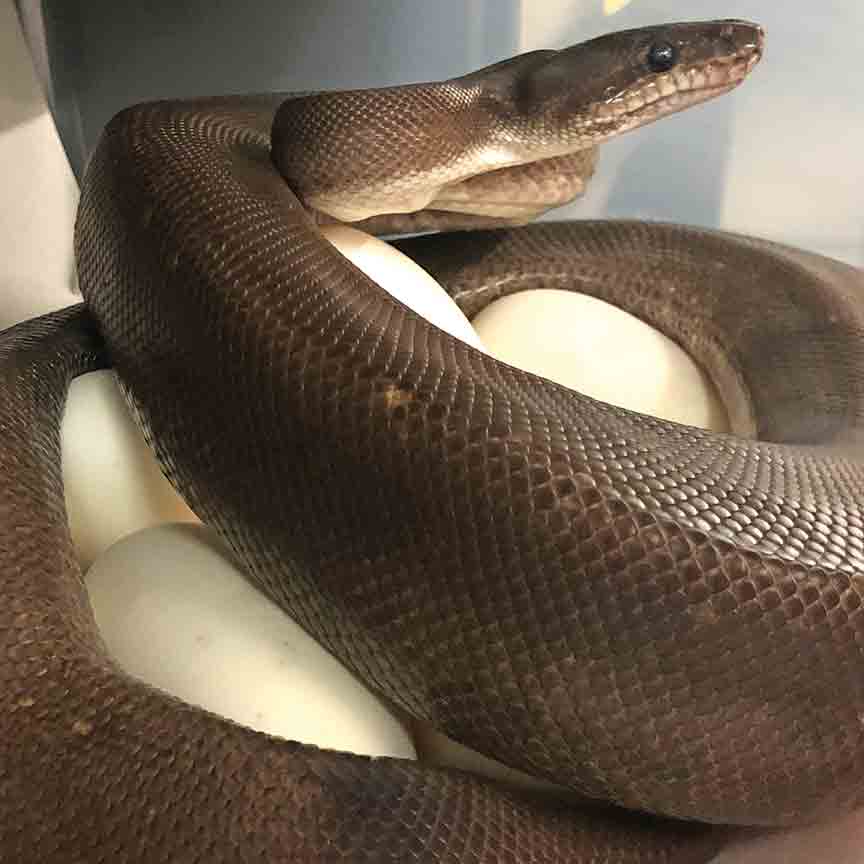
Super Cinnamon het Pied on a clutch of eggs. Photo by Rebekah Pettit.
Captive conditions are modified during breeding and males are placed into the habitat with females leading up to their ovulations. Ovulation is observed by the swelling of the female’s whole body, which indicates the development of ovarian follicles. When not fertilized, follicles are typically reabsorbed into the female’s body. Breeding occurs seasonally between November and April and male/female cohabitation can last a few hours to up to a week to assist in successful fertilizations called locks. It is possible, but not often, for multiple males to sire viable clutches. Males are placed in the habitat with females before ovulation and observed over time. They are then removed when females begin to ovulate. Male cloaca spurs are used for courting females by moving against the female’s body to initiate mating. Females also have cloacal spurs but they are smaller and poorly understood. The sex of snakes can be determined by ultrasounds, physical stimulation, and/or probing the sexual organs with sterile tools.
Fertilization occurs at a specific time during follicular growth and is facilitated when males successfully lock their reproductive organs with the females’. Pairings are usually documented by breeders in regards to genetic combinations and dates. Males are typically seven months to 1.5 years old before they can breed, weighing over 500 grams on average. Females are larger to sustain eggs and the breeding process is physiologically harder on them compared to males.
Females must be a minimum of 1400-1600 grams and 1.5 years old before breeding, but can sometimes take up to 3-4 years to have healthy clutches. Females at Trademark Exotics are not bred until at least 1800 grams to ensure healthy, decent sized clutches and to not overwork the females.
Clutch sizes range between 3 to 16 eggs but average more between 6 to 7 eggs. In the wild and in captivity, females can stop eating to incubate their eggs by sitting on them for about two months. This process can be stressful. To avoid this stress, clutches are removed and the habitat is cleaned so she cannot recognize the scent of her eggs. Her body must also be proficiently cleaned or she will remain in the coiled, brooding position because of the associated scent. Females lose weight after laying, but usually resume normal behavior shortly after. This process can be repeated upon breeder discretion.
Ball Python Egg Incubation
In the wild, ball python eggs are laid in various depressions in the ground where they are incubated by the mother. She coils around the eggs to protect them from predators and uses her energy to thermoregulate them until they hatch. This type of parental care is seen in multiple species of pythons. In captivity, eggs can be collected after deposition and artificially incubated for maximum hatching success. Incubators vary greatly in customization and brand and incubation methods vary by breeder.
It is important for incubators to be calibrated properly and consistently. Ball python eggs are leathery and sometimes stick together once they are laid. Some breeders peel them apart and others do not. It is helpful to document the orientation of the eggs with a pencil mark because embryo attachment is almost immediate in ball pythons. This placement is fragile and secures the developing embryo inside the egg. It is important to keep them properly oriented to avoid detaching the embryo as this will kill it. The embryonic attachment can be seen when candling fertilized ball python eggs with a light. As they develop, snakes are connected by an umbilicus which is attached to the egg (as opposed to mammals, who are connected by a placenta). This facilitates material exchange between the developing snake and the various membranes inside the amniotic egg.
Once the eggs are deposited and orientation is documented, they are immediately placed into nearly airtight, containers. Inside of these containers, eggs are carefully placed on a variety of substrates like perlite, vermiculate, and other materials. Substrates are mixed at a 1:1 weight ratio with water. This maintains the required 99-100 percent humidity inside of the container. Moisture is important and adding water may be necessary at times if the substrate becomes too dry. Some seal the egg box with plastic wrap on top before the lid is closed, so moisture does not escape. Clutches are then placed inside an incubator and monitored for 60 days. Inside the incubator temperatures should be between 88-90 degrees Fahrenheit and 99-100% humidity.
Temperatures must not exceed 90 degrees Fahrenheit. These can be monitored with thermostats and hygrometers. When fully developed, indentations can be seen in ball python eggs. Some choose to assist the snakes in evacuating the egg by carefully creating a small slit in the top. This helps them break out of the egg without issues. Others choose not to assist, and allow the snakes to naturally leave the egg by slicing it with their egg tooth. Sometimes there are issues with the natural method and trying to get out of the egg can tire them or they become tangled in their umbilicus.
Ball pythons hatch at a decent size between 6-12 inches. Most of the time the yolk sac is fully absorbed by the time of hatching, but it can sometimes be present for a day or two after they evacuate the egg. Yolk sacs provide immediate nutrients for the hatchlings to begin living. Hatchling care is generally similar to adults, but they can be placed on wet paper towels to promote their first healthy sheds with high humidity. After about 1-2 weeks, they shed and begin eating. Incubation and breeding methods are variable and highly debated.
Ball pythons are often recommended as “easy” beginner reptiles, but they are susceptible to a plethora of health conditions that can be challenging to manage. These include, but are not limited to viral, bacterial, parasitic, and fungal infections. Some of these issues require vet care, injections and other prescription treatments. Ball pythons are wonderful animals and can live for many decades when they are properly cared for. This has fascinated and inspired the world to learn more about them. The species-specific care required for ball pythons should not be underestimated, but instead progressed through the dedicated captive management of the species. Among the inspired, we at Trademark Exotics are committed to producing the highest quality captive-bred reptiles available. It is a continuous privilege and passion to care for ball pythons, who have opened the door to the vast possibilities of captive-bred reptiles. Ball pythons may now be regarded as a common species, but their history, care, and traits are unique and diverse. Python regius has earned its special place in herpetoculture which was made possible by their valuable natural qualities.
Rebekah Pettit is a zoologist and middle school teacher based in Florida. She is co-owner of Trademark Exotics.

